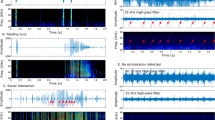Summary
The use of other individual's echolocation calls by little brown bats, Myotis lucifugus, was tested by observing the response of free-flying bats to presentations of recorded echolocation calls and artificial sounds. Bats responded by approaching conspecific calls while searching for food, night roosts, nursery colonies and mating/hibernation sites. Response was low or non-existant to other sounds. While searching for prey, M. lucifugus also responded to the echolocation calls of Eptesicus fuscus, a sympatric species with overlapping diet but distinctly different echolocation calls. Subadults were especially responsive to conspecific calls.
All four situations in which the bats responded involve patchily distributed resources at which bats accumulate. Concentrations of echolocation calls thus likely serve as cues regarding the location of resources. Individuals approaching feeding groups, for example, could increase prey detection range by up to 50 times over individuals relying solely on their own echolocation.
Although the costs associated with eavesdropping may be negligible for M. lucifugus, for other species, particularly territorial ones, being conspicuous may be a disadvantage and the possibility of being over-heard by other bats may have been one factor involved in the evolution of echolocation call design.
Similar content being viewed by others
References
Anthony ELP, Kunz TH (1977) Feeding strategies of the little brown bat, Myotis lucifugus, in southern New Hampshire. Ecology 58:775–786
Anthony ELP, Stack MH, Kunz TH, (1981) Night roosting and the nocturnal time budget of the little brown bat, Myotis lucifugus: Effects of reproductive status, prey density, and environmental conditions. Oecologia (Berl) 51:151–156
Barclay RMR (1981) Interindividual use of echolocation calls: Eavesdropping by the little brown bat, Myotis lucifugus. Unpublished PhD thesis, Carleton University Ottawa, Canada, p 100
Barclay RMR (in press) Night roosting behavior of the little brown bat, Myotis lucifugus. J Mammal
Barclay RMR, Fenton MB, Thomas DW (1979) Social behavior of the little brown bat, Myotis lucifugus. II. Vocal communication. Behav Ecol Sociobiol 6:137–146
Bell GP (1980) Habitat use and response to patches of prey by desert insectivorous bats. Can J Zool 58:1876–1883
Belwood JJ, Fenton MB (1976) Variation in the diet of Myotis lucifugus (Chiroptera: Vespertilionidae). Can J Zool 54:1674–1678
Bradbury JW (1970) Target discrimination by the echolocating bat, Vampyrum spectrum. J Exp Zool 173:23–46
Buchler ER (1980) The development of flight, foraging and echolocation in the little brown bat (Myotis lucifugus). Behav Ecol Sociobiol 6:211–218
Busnel R-G, Fish JF (1980) Animal sonar systems. Plenum Press, New York, p 1135
Caldwell GS (1981) Attraction to tropical mixed-species heron flocks: Proximate mechanism and consequences. Behav Ecol Sociobiol 8:99–103
Darlington NE (1977) Some aspects of the feeding habits of Eptesicus fuscus (Chiroptera: Vespertilionidae). Unpublished BSc thesis, Carleton University, Ottawa, Canada, p 25
Fenton MB (1969) Summer activity of Myotis lucifugus (Chiroptera: Vespertilionidae) at hibernacula in Ontario and Quebec. Can J Zool 47:597–602
Fenton MB (1980) Adaptiveness and ecology of echolocation in terrestrial (aerial) systems. In: Busnel R-G, Fish JF (eds) Animal sonar systems. Plenum Press, New York, pp 427–446
Fenton MB, Bell GP (1979) Echolocation and feeding behaviour of four species of Myotis (Chiroptera). Can J Zool 57:1271–1277
Fenton MB, Bell GP (1981) Recognition of species of insectivorous bats by their echolocation calls. J Mammal 62:233–243
Fenton MB, Fullard JH (1979) The influence of moth hearing on at echolocation strategies. J Comp Physiol 132:77–86
Fenton MB, Morris GK (1976) Opportunistic feeding by desert bats. Can J Zool 54:526–530
Fenton MB, Thomas DW, Saseen R (1981) Nyteris grandis (Nycteridae): An African carnivorous bat. J Zool (Lond) 194:461–465
Fiedler J (1979) Prey catching with and without echolocation in the Indian falsc vampire (Megaderma lyra). Behav Ecol Sociobiol 6:155–160
Fullard JH, Thomas DW (1981) Detection of certain African, insectivorous bats by sympatric, tympanate moths. J Comp Physiol 143:363–368
Griffin DR (1958) Listening in the Dark. Yale University Press, New Haven, Connecticut, p 413
Griffin DR (1971) The importance of atmospheric attenuation for the echolocation of bats (Chiroptera). Anim Behav 19:55–61
Griffin DR, Webster FA, Michael CR (1960) The echolocation of flying insects by bats. Anim Behav 8:141–154
Kick SA (1980) Target detection by echolocation in the bat, Eptesicus fuscus. Paper presented at the 11th North American Bat Research Symposium, Los Angeles California, 21.–22. November 1980
Krebs JR (1974) Colonial nesting and social feeding as strategies for exploiting food resources in the great blue heron (Ardea herodias). Behaviour 51:99–134
Miller LA (1971) Physiological responses of green lacewings (Chrysopa, Neuroptera) to ultrasound. J Insect Physiol 17:491–506
Möhres FP (1966) Communicative characters of sonar signals in bats. In: Busnel R-G (ed) Animal sonar systems: Biology and bionics, vol 2. Jouy-en-Josas, Laboratoire de Physiologie Acoustique, pp 939–945
Novick A (1977) Acoustic orientation. In: Wimsatt WA (ed) Biology of bats, vol 3. Academic Press, New York, pp 73–287
O'Shea TJ, Vaughan TA (1977) Nocturnal and seasonal activities of the pallid bat, Antrozous pallidus. J Mammal 58:269–285
Peterson RL, Kirmse P (1969) Notes on Vampyrum spectrum, the false vampire bat, in Panama. Can J Zool 47:140–142
Simmons JA, Stein RA (1980) Acoustic imaging in bat sonar: Echolocation signals and the evolution of echolocation. J Comp Physiol 135:61–84
Simmons JA, Fenton MB, Ferguson WR, Jutting M, Pallin J (1979) Apparatus for research on animal ultrasonic signals. Life Sci Misc Publ, Roy Ont Mus, p 31
Thomas DW, Fenton MB, Barclay RMR (1979) Social behavior of the little brown bat, Myotis lucifugus. I. Mating behavior. Behav Ecol Sociobiol 6:129–136
Thomson CE (1981) Mother-infant interactions in free-living little brown bats, Myotis lucifugus (Chiroptera: Vespertilionidae). Unpublished MSc thesis, Carleton University, Ottawa, Canada, p 92
Vaughan TA (1980) Opportunistic feeding by two species of Myotis. J Mammal 61:118–119
Author information
Authors and Affiliations
Rights and permissions
About this article
Cite this article
Barclay, R.M.R. Interindividual use of echolocation calls: Eavesdropping by bats. Behav Ecol Sociobiol 10, 271–275 (1982). https://doi.org/10.1007/BF00302816
Received:
Accepted:
Issue Date:
DOI: https://doi.org/10.1007/BF00302816



